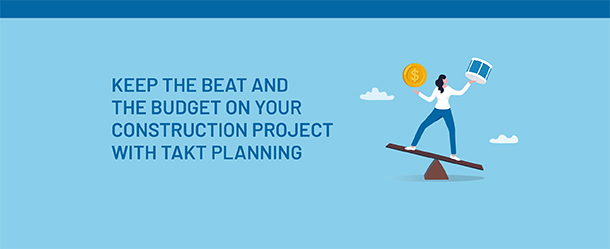



Construction projects can be notorious for going off the rails. Any number of things can go wrong and do. To help ensure projects are delivered on time and within budget, forward-thinking construction managers are turning to Lean construction concepts like takt planning.
Developed in Germany in the 1930s, the term “takt” originates from the German word for “pulse” or “beat” and refers to the pace at which the customer needs products or projects produced. Like the beat of a drum, takt planning aims to maintain a rhythm that results in maximum efficiency at peak complexity in industries like manufacturing, automotive, and, increasingly, construction.
You can visualize the takt system as a train where work zones are connected in a continuous flow. As shown in the sample takt plan below, each zone is designed to complete its task within a specific time frame, known as the “takt time,” which is synchronized with project demand.
A “takt wagon” in this context is analogous to a physical container or carrier that moves along the train tracks, carrying the product, or task. The wagon is designed to move from one work zone to the next in a predetermined sequence and defined timeframe, with each zone completing its assigned task on the project before passing it along to the next zone. This allows for a smooth and efficient production process, continuously moving along the track until completion.


A takt planner must be familiar with the specific requirements of each task and the related needed resources. This role requires clear communication and the ability to adjust in real-time to keep the project on track. Ultimately, the success of takt planning relies on the balancing of multiple moving parts to create a harmonious whole.
I have presented on the topic of takt at several industry events and conferences over the past few months. In several conversations, I have learned of projects that could have significantly benefited from the early involvement of takt planning. One such project was a four-story, luxury apartment building with 35 units on each floor that varied in size. The project was about 75% complete and the team could not communicate effectively. The subcontractors were not shown the CPM schedule and could not complete tasks due to coordination issues and conflicting directions from the architect and owner. Work did not flow in a logical fashion and the owner’s representative complained when work was not being performed in available areas. Even though the team eventually warmed up to the takt approach, the project team’s communication was too far gone for takt to make a significant difference.
Unfortunately for the troubled project discussed, takt is not an immediate turnaround tool for projects nearing completion. It is most effective when applied at the project’s outset. Takt planning can provide a structured framework to bring all stakeholders together, align their objectives, and optimize their resources toward achieving common goals. However, the success of takt planning depends on the willingness of all parties to collaborate and embrace the approach of reducing the sequence of an entire project to one document.
Having the team on board at the beginning of a project is critical to takt success. It is essential to involve all stakeholders to understand their concerns and seek their input on a plan that works for everyone. If stakeholders can work together to execute the plan, resolve issues, and adjust the approach as needed, takt planning can improve project cohesiveness, mitigate delays, and ultimately deliver a successful project.
Takt planning wouldn’t be takt planning without visual aids. Independent of the colors on the takt plan shown above, floor plans can be enhanced by expanding sight lines and improving communication. Specific indicators can be assigned to tasks. For example, solid shading can indicate that a task is complete, diagonal lines can show that the task is in progress, and squares can indicate that the task is behind schedule. With this approach, stakeholders can rapidly discern the status of each activity and any potential conflicts.

Added visuals can simplify the takt planning process and help stakeholders identify potential issues early. They allow stakeholders to track progress, spot bottlenecks, and make timely decisions to resolve them.
A buffer can also be inserted into the takt train to minimize impacts. A buffer refers to strategically placed extra time or resources to handle unexpected delays or variations in the process, helping maintain the overall project pace. Buffers ensure that work can continue smoothly even when there are minor disruptions, preventing a project from falling behind schedule.
Waste in construction can manifest in various forms, such as overproduction, defects, unnecessary inventory, inappropriate processing, excessive transportation, waiting, unnecessary motion, and making-do.
In the earlier apartment example that resisted takt, waste was created because the trades had to regularly do comeback work when activities were not fully completed. They were given 20 workdays on a floor but only reached 80-90% completion before moving on to the next floor. Unclear design coordination and changing owner expectations resulted in unpredictable work variation that left the trades frustrated and work incomplete. Takt planning can reduce waste by promoting better coordination and communication, maintaining productivity during variances, and ensuring the efficient use of resources.
Takt planning is a simple yet effective tool to help keep construction projects on time and within budget, but the right conditions are necessary to realize the full potential of the takt approach. As with most planning and coordination tools, clear and concise communication is crucial to success. Project stakeholders must recognize and report potential conflicts, identify solutions early, and create a buffer to implement the takt plan successfully.
You should also implement takt early in the construction process. A simple-to-read, color-coded document allows for easy comprehension of work locations and expected production by the trades.
Takt has tremendous potential to revolutionize the management of construction projects, helping to usher in a level of efficiency the industry has yet to experience.
Comments